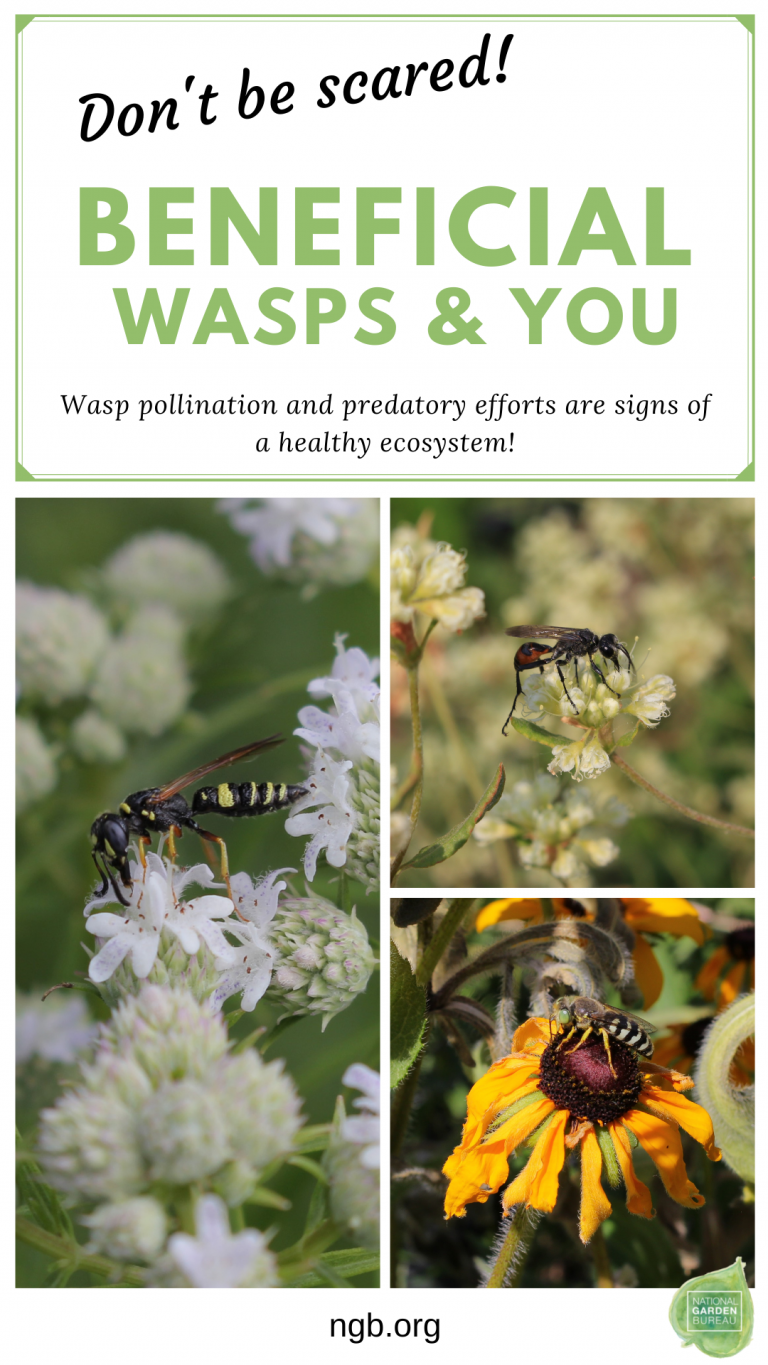Originally appeared in Nation Garden Bureau
Don’t be scared!
Did you know…Wasp pollination and predatory efforts are signs of a healthy ecosystem!?!
What is the first thing you think of when you hear, “wasp”? Was it a yellow jacket, hornet, fear, nuisance, pain?
What about beneficial wasps? Have you heard of them? What do you think they do? For many, the concept of a “beneficial wasp” is entirely foreign and difficult to believe. There are actually thousands of species of wasps in the United States alone, with the vast majority being solitary, non-aggressive wasps.
These wasps keep to themselves and provide multiple ecosystem services including pollination, but are especially critical for pest control in our gardens, public lands, and croplands. This month we challenged ourselves to see just how many different beneficial wasps we could find and photograph in our gardens at Applewood Seed Company.
Wasp species have a complex evolutionary history and are generally divided into two superfamilies, the Apoidea (which also includes bees), and Vespidae. Of the several Apoid species we found, Bembix (below, on Rudbeckia) is one of the most striking. These Sand Wasps have fluffy faces with brilliant green eyes, and swiftly dig their nests in sandy soil where they progressively provision their larvae with flies over a series of days.
Apoid Family of Beneficial Wasps
Bee Wolves or Digger
Among Philanthus species (above on Pycnanthemum, a mountain mint), called Bee Wolves or Digger Wasps, larvae feed on bees provided by the mother. Females cultivate beneficial bacteria in the bases of their antennae that they apply to their brood cells in order to protect from harmful microorganisms, a la antibiotics.
Sphecid – Thread-waisted
Sphecid, or thread-waisted wasps are very common Apoids. At Applewood, there were multiple genera that prey on Grasshoppers and Crickets (also known as the Orthoptera family or Orthopterans.) The Thread-waisted Wasp genus Prionyx (on Buckwheat, Eriogonum spp.) provisions nests with paralyzed adult grasshoppers that they lay a single egg on.
Isodontia elegans – Elegant Grass-carrying
Isodontia elegans, the Elegant Grass-Carrying Wasp (feeding here on Mountain Mint), is often seen flying with grass blades that they line their nests with. Crickets and grasshoppers are the provisions placed in divided cells within trees, hollow stems, or other cavities.
Sphex – Thread-waisted Digger
Sphex wasps are a somewhat larger Thread-waisted Digger Wasp genus that preys on katydids and other Orthoptera. Females are ground-nesters and have pronounced tarsal-rake spines on their forelegs (like extra bristles on their front feet) that help them dig out their nests. They are common visitors to Rattlesnake Master (Eryngium yuccifolium).
Vespidae Family of Beneficial Wasps
Vespidae are another large wasp family that includes the social Yellowjackets and Paper Wasps but also many solitary species. Interesting, most of these solitary wasps stock their nests with caterpillars.
Stenodynerus and Pterocheilus are two types of Potter wasps. They use mud to build their brood cells and mostly feed moth larvae to their young. Cuckoo wasps (which are featured below) often infest these types of wasps.
Chrysidid, Jewel Wasp or Cuckoo
One of the glittering jewels of the gardens, Chrysidid, Jewel Wasp, or Cuckoo Wasps (above on Goldenrod) are tiny cleptoparasites, most often parasitizing other wasp and bee larvae. This large family of wasps is actually stingless and the unique pitted surface of their bodies produces their shimmery colors.
Tarantula-hawk
Fear not, arachnophobes- Tarantula-hawk wasps (Pepsis species), are a glimmering sight to behold. These large wasps are fond of milkweed (in this case, Broad-leaved Milkweed, Asclepias latifolia). They lay single eggs on paralyzed tarantulas or other large spiders that they bring to their nests. These giants can be intimidating and have a powerful sting, but are gentle and non-aggressive.

Multiple thread-waisted wasps are found on either side of a male Halictus sweat bee and cuckoo wasp. Large goldenrod fronds are often buzzing with a diverse collection of beneficial wasps and other pollinators












